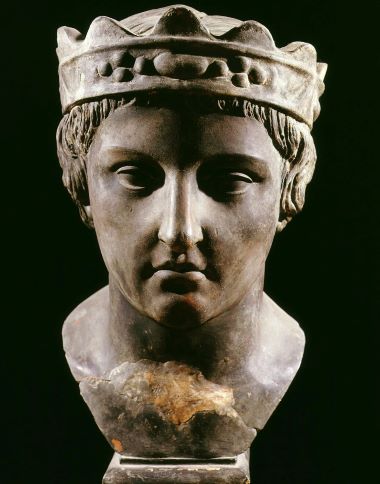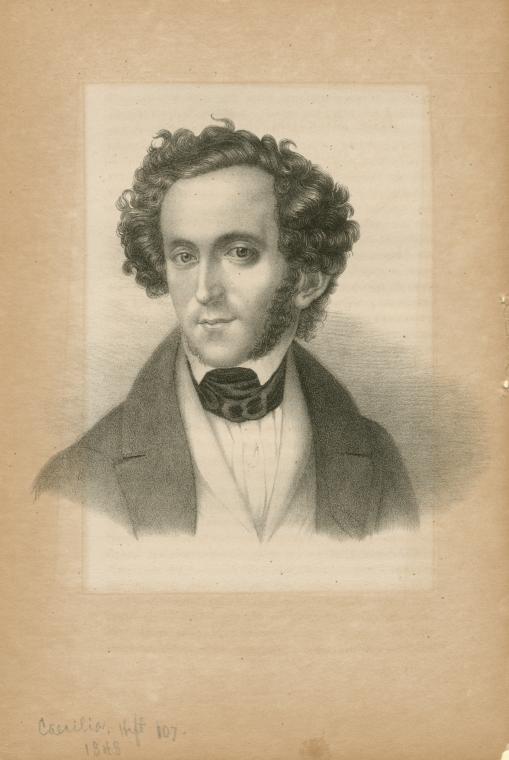‘Triumph of the Octagon’ is a multifaceted win for Riccardo Muti and CSO in Glass premiere
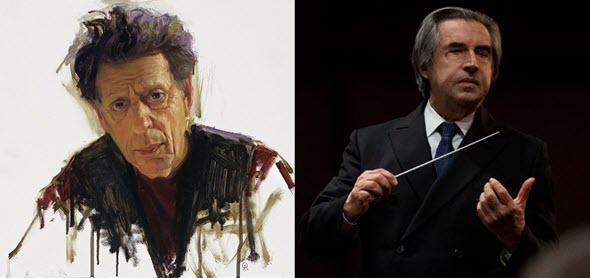
“The Triumph of the Octagon,” composed by Philip Glass, left, received its world premiere by the Chicago Symphony Orchestra, led by Riccardo Muti. The work will have its New York premiere Oct. 5 when the CSO and Muti perform at Carnegie Hall. (Philip Glass, left, oil on board by Luis Alvarez Roure, Smithsonian Portrait Gallery; Riccardo Muti photo by Todd Rosenberg)
Review: Chicago Symphony Orchestra conducted by Riccardo Muti, at Orchestra Hall.
By Nancy Malitz
It began with a quiet ripple, serene and a little mysterious, and gentle two against three syncopations among the strings and harp, pitches slowly rocking. Like sunlight on the vast surface of giant body of water, the impression was not so much that music had just begun, but rather that the music was already there.
“The Triumph of the Octagon,” a Sept. 28 world premiere commissioned by the Chicago Symphony Orchestra Association for Riccardo Muti, honors the esteemed conductor’s transition from music director (a title he held from 2010 until June 2023) to his new role as music director emeritus for life. The tone poem by Philip Glass, with its quiet undulations, beautifully commemorates the CSO’s season of transition: the orchestra’s capacity for singularly tranquil, unhurried and quite magical effects will linger as earmarks of Muti’s legacy.
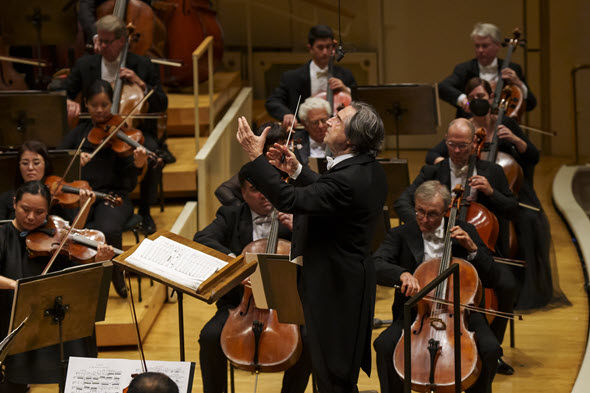
Conductor Riccardo Muti, CSO music director emeritus for life, will introduce the new work with the CSO at New York’s Carnegie Hall and various European venues. (Todd Rosenberg photo.)
The new composition ‒ for harp and strings, with oboe and clarinet, and finally the flute, adding increasingly ecstatic voices ‒ is relatively brief at 13 minutes, and its shimmering impression lingers. It was my favorite of the three works in a well-designed program of homage to the sunlit colors of the Mediterranean: Mendelssohn’s Symphony No. 4 (“Italian”) inspired by the young composer’s two-year grand tour of Italy as he came of age in 1830, and Richard Strauss’ “Aus Italien” after a trip for the same purpose some 56 years later.
This is not to argue that the concert’s three composers – Glass, Mendelssohn and Strauss – shared the same aesthetic. A hallmark of Glass’ music is that when it ends, well, it ends. The gentle riddling of “The Triumph of the Octagon” does not build a grand crescendo toward a mighty climax that cues applause.
Instead, after beginning softly and simply, just strings and harp, it gains chromatic color with each new woodwind layer as the oscillations and ecstatic intensities increase, until the lushness evaporates on a weak beat during a steady run of sixteenth notes, as if a breeze had caught hold of the music and simply whisked it all away. My first reaction was, “Wait, what?” My second, to smile. Neither Glass, at 86, nor the maestro, at 82, has lost his capacity for surprise.
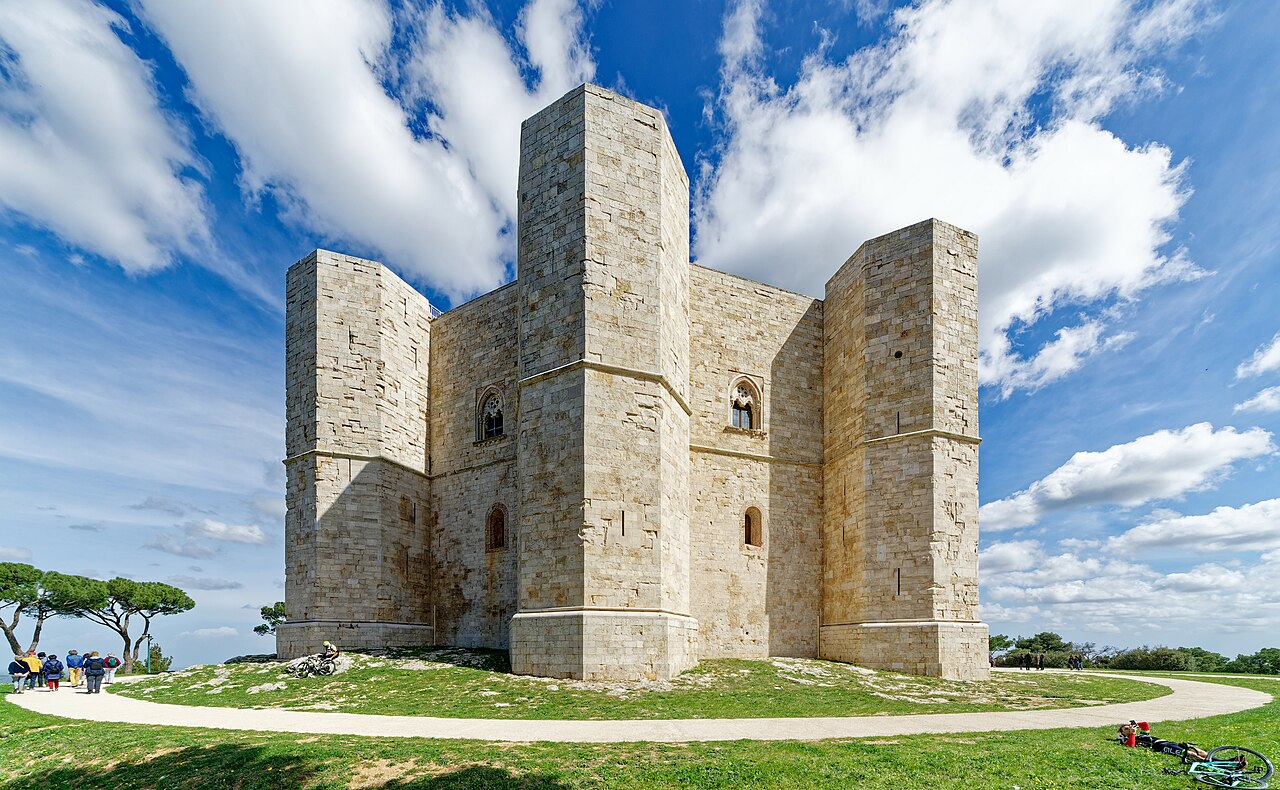
It was an image of the 13th-century Castel del Monte, with its octagon shape and tall towers, that inspired Glass to create his new work. The glorious fortress, which looks out to the sea, is not far from a dwelling in southern Italy that Muti owns. (Holger Uwe Schmitt poho, Wiki Commons)
As Muti tells it, the inspiration for “Triumph of the Octagon” was a photo that Glass observed on the wall of Muti’s studio at Symphony Center. The eight-sided Castel del Monte, with towers at each corner, was built according to the specifications of Frederick II in the 13th century, and it remains a majestic sentinel of limestone, marble and fragmented coral-infused rock; the mix shimmers in the light as the castle looks out to sea.
Frederick had many titles, including King of Sicily from 1198, King of Germany from 1212, King of Italy and Holy Roman Emperor from 1220, and King of Jerusalem from 1225, although he eventually found himself at odds with the papacy. He died in 1250 but is remembered as a persistently inquisitive leader who spoke six languages and was distinguished as a scientist, scholar, architect and poet. His Castel del Monte fortress, in addition to appearing on the Italian euro 1-cent coin, is now commemorated in Glass’ enigmatically oscillating opus.
(Glass was not in Chicago for the premiere, but the New Yorker is expected to appear to take a bow when the CSO introduces “The Triumph of the Octagon” at Carnegie Hall on Oct. 5.)
One doesn’t often hear Strauss’ “Aus Italien” these days; the 1886 work was first done here in 1899 under the direction of Theodore Thomas and later fell out of fashion. Muti introduced it again in 1973 at the Ravinia Festival, and then downtown in 2011, but it remains a rarity. On these concerts, “Aus Italien” occupied the program’s full second half. A travelogue of sorts, a love letter to the world that was opening to this 21-year-old composer, it records dizzying impressions of the sunlit countryside, majestic Roman ruins, singing birds, ocean waves, Neapolitan song, even the funicular cable and urban bustle. It’s only Strauss’ 16th opus, the coming-of-age work of an enthusiast young composer whose raw creativity was exploding.
One thinks of many other composers who made the same life-changing trip south from cooler climes ‒ among them Handel, Beethoven, Schubert, Brahms, Mahler, Liszt, Tchaikovsky. If “Aus Italien” seems like 45 minutes of exuberant excess, well, it is, but it’s also strikingly youthful and prodigious. There’s incipient “Till Eulenspiegel” playfulness in it, and the massive structures of “Also sprach Zarathustra,” too. In Chicago, “Aus Italien” arrived at a perfect time, with the last indulgent lingering of summer.
The gem of the CSO evening, for me, was Mendelsohn’s “Italian” Symphony, also influenced by the composer’s coming-of-age sojourn to the sunlit south. Why the composer began working on it in 1830 but never selected it for publication remains a mystery to me, although his 38-year lifespan was brief in any case. The sparkling work remains popular to this day, its finale a tumbling saltarello, its first movement an infectious joy, and its slow movement a hypnotic procession that seems to summon antiquity.
Mendelssohn’s many instrumental cameos served as a reminder of how well-fitted Muti has left the CSO. Its virtuosic assemblage of burnished horns, powerful strings and exuberant winds is led by distinctive solo players throughout. The grooming took careful, patient work and doubtless involved some difficult choices. But there is no doubt that wherever in the CSO one’s ear focuses today, there is finesse, power, an elite ensemble spirit and virtuosity.

